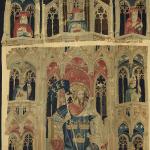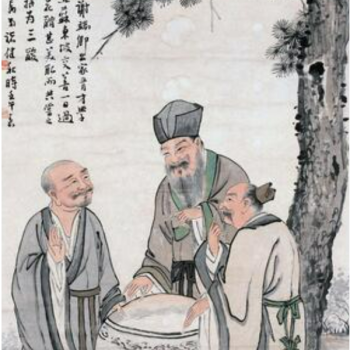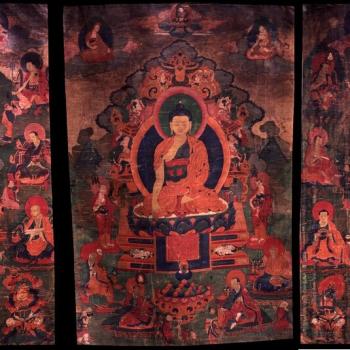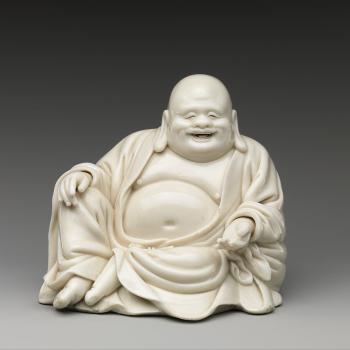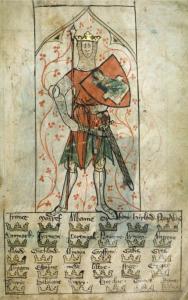
If one were to compile a list of texts that have defined the shape and scope of the Arthur story in the popular imagination, Geoffrey of Monmouth’s Historia Regum Britanniae (History of the Kings of Britain) and Sir Thomas Malory’s Le Morte d’Arthur (The Death of Arthur) would be at the top. Geoffrey’s text is generally regarded as the beginning of Arthurian literature as we know it. He did not invent Arthur; as shown last week, the king had a long prehistory in Welsh, Cornish, and Breton tradition. But he did reinvent him in a transformative manner, giving his story a coherent shape and painting it in colors that medieval people across Western Europe could recognize, understand, and respond to. Similarly, Malory’s Morte is often cited as the “definitive Arthurian text,” the one that defined our modern image of Arthur and his realm. While the claim is now somewhat hyperbolic—the public’s received idea of the King Arthur story is probably more of an amorphous mixture of Tennyson, T. H. White, Disney’s Sword and the Stone, and Monty Python and the Holy Grail than it is genuine Malory at this point—it does underscore the central role the text in shaping perceptions of Arthur and the Arthurian world for over five-hundred years.
That being said, dipping into Geoffrey or Malory is bound to come as a shock for anyone raised on a steady diet of pop-culture Arthuriana. These texts, while laying the foundations for all that has come after in the Arthurian scheme, are so very unlike what has been reproduced across popular culture. There is a strangeness to them, a sense that their Arthur is not our Arthur, that he is something quite different. Both Geoffrey and Malory were writing for a time and an audience that had very different expectations of what makes an ideal monarch, expectations that were often tied to the figure of the Last World Emperor. Neither Geoffrey nor Malory, I think, are unaware of the Last Emperor idea. In fact, I believe that both use it directly in creating their versions of King Arthur, with the understanding that the preexisting story of Arthur’s immortality makes him he perfect candidate to be the Last World Emperor at the end of days. In short, both Geoffrey and Malory’s texts can be read not just as imagined biographies of Arthur and chronicles of his reign, but as prehistories of the Last World Emperor narrative inherited from the Apocalypse of Methodius, the Tiburtine Sybil, and the long tradition of prophecy both of those works inspired.
Beginning with Geoffrey, the earlier of the two, this is most apparent in the curious fact discussed in detail last time, that Geoffrey, in both the Historia and the later Vita Merlini, makes Arthur immortal but gives him no role in the long-foretold future salvation of the British nation. In the latter work, Morgan le Fay requests simply that Arthur “be with her for a long time” (Vita Merlini ll.936-37) in order to heal his fatal wound, implying that his stay in Avalon is for a finite, albeit quite lengthy, period and that he will someday come back. But Geoffrey gives no indication here of what he will do when that time comes, only of what he won’t do, which is save the Britons from the Saxons. The substance of his return is left undefined and open to possibility. And the only other possibility that would have suggested itself to the medieval mind was that Arthur would come back to fulfill the role of that other great monarch “whom men had supposed to be dead and good for nothing” (Pseudo-Methodius 13:11), the Last World Emperor.
The Last Emperor myth does more than explain the mystery of Arthur’s end. It also throws light on Geoffrey’s portrayal of Arthur himself. For, while Geoffrey duly shows Arthur as the resolute Saxon fighter and throws in a few lines that show him ruling peacefully over a prosperous, utopian Britain, his main interest in Arthur is as an international figure who roams across Europe and reduces countless nations to vassalage. It is the story of Arthur’s conquests on the continent that most holds Geoffrey’s attention; he even remarks that Arthur “rejoiced that he was everywhere feared and thought to subdue all Europe to himself” (Historia IX: 234-36). This ambition, and Arthur’s success at bringing it about, eventually lands him in a climactic conflict with the Roman Empire, which summons allies from as far afield as Persia and Africa to battle the Britons, turning the struggle into what a medieval person would have understood as a kind of world war. This aspect of Arthur, his being a world conqueror, was not invented by Geoffrey. It had previously appeared in Culhwch and Olwen (as noted previously). But Geoffrey brought it to the fore like no one had ever before.
Geoffrey made Arthur’s battles against the major powers of the time the main substance of his story, foregrounding Arthur’s role as global conqueror and worldwide monarch almost to the exclusion of everything else. This is exactly the type of figure the Last World Emperor was expected to be. Both the Apocalypse of Methodius and the Oracle of the Tiburtine Sibyl portray the Last Emperor as a “King of the Greeks and Romans” but also as the ruler of the entire world, a position that he attains through conquest. Now, of the two, it is most likely that Geoffrey was working from the Tiburtine Sibyl’s account or one derived from it, for his Arthur more resembles the version of the Emperor found there than the one in Pseudo-Methodius.
Like that Emperor, Arthur is a renowned pagan fighter and a conqueror of nations, while the Emperor of Pseudo-Methodius is primarily a deliverer who battles the encroaching forces of Islam. Just as the Sibylline Emperor fought the nations of Gog and Magog that hailed from the far north—something that the Methodian Emperor is not allowed to do—Arthur subdues the northern nations of Denmark and Norway and does battle with forces hailing from the known limits of the world during his war with Rome. Arthur’s reign, apparently beginning sometime around the mid-fifth century during the early waves of Saxon incursion, does not end until the mid-sixth, “in the 542nd year after the incarnation of the Lord” (XI: 83-4). This supernaturally long period of rule of around a hundred years would become a fixture of Arthurian literature from Chrétien to Malory. But it is largely inexplicable until one remembers that the Tiburtine Sibyl had remarked that the Last Emperor’s “reign will be limited to 112 [later restated as 120] years” (Sibylinnische Texte 185). Arthur’s own century-long rule thus aligns him even further with the Sibylline Last Emperor. Even the Emperor’s personal name of Constans finds a strange reflex in Geoffrey; there, Constans is Arthur’s uncle and a prior (albeit unspectacular) King of Britain.
And just as the Emperor of the Tiburtine Sibyl arbitrarily decides to seek the worldwide emperorship based on reading a prophecy— “And the King will have before his eyes the scripture saying: ‘The King of the Romans shall claim the rulership of the Christians for himself’” (185)—so too does Arthur decide to challenge the Roman Empire for global rule based upon the reading of a prophecy. Except in Arthur’s case, the prophecy seems to be a garbled rendering of the Oracle of the Tiburtine Sibyl itself. When Arthur is taking council about whether to go to war with Rome, his kinsman King Hoel of Brittany tells him, “Indeed this conflict should be desired by all the Britons, given the prophecies of the Sibyl, whose true verses testify that for a third time there will be a man born of the British nation who shall obtain the Roman emperorship. The oracles themselves have since been fulfilled regarding the first two, which is made clear, as you have said, by those brilliant princes Belinus and Constantine having worn the regalia of the Roman Empire. Now truly we have in you the third man to whom such a height of honor is promised” (Historia IX: 491-97).
Here, a prophecy of the Sibyl is directly invoked. What is more, it is a prophecy regarding the Roman Empire and the identity of a future Emperor, the last in a lineage—in this case, the lineage of British rulers of the empire. This suggests that Geoffrey is specifically thinking of the Tiburtine Sibyl’s Last World Emperor prophecy here, which similarly expounds upon the identity of a future, final Roman Emperor. This has important implications for Arthur’s war with Rome. It is easy, at first glance, to think that Arthur launches the war to replace the Roman Empire with his own. But this passage reveals that Arthur launches the war to become Roman Emperor and to fulfill the role laid out in the Sibyl’s prophecy. It is thus deeply important for Geoffrey that Arthur both claim the title of Roman Emperor and fulfill the prophecies of the Tiburtine Sibyl. Holding the title of Roman Emperor was the chief qualification a ruler needed to be the long-awaited Last Emperor. Thus Arthur’s need to claim the title based on prophecy suggests that he is meant to fulfill the Last World Emperor’s prophecised role. Furthermore, since the Sibyl laid out the path that the Last Emperor’s career was to take as Geoffrey knew it, Geoffrey is explicitly tying Arthur into the prophecy of the Last Emperor but suggesting that it was he whom the Sibyl’s imperial prophecies were referring to all along. and making clear that Arthur is the prime candidate to become the Last World Emperor of the end-times.
Except that, in the end, Arthur never achieves his dream of becoming Roman Emperor. This is not due to failure on the battlefield. When he encounters the Romans and their global coalition consisting of “Epistrophus, King of the Greeks, Mustensar, King of the Africans, Ali Fatima, King of Spain, Hirtacius, King of the Parthians, Boccus, King of the Medes, Sertorius, King of Libya, Serses, King of the Itureans, Pandrasus, King of Egypt, Micipsia, King of Babylon, Politetes, Duke of Bithynia, Theucer, Duke of Phrygia, Evander of Syria, Echion of Boetia, and Hippolytus of Crete” (X: 3-7), Arthur, like the Christ of Revelation, defeats the assembled kings of the earth in an apocalyptic final battle, not at Mount Megiddo but instead at “a valley … that was called Siesia” (X: 241-42). Arthur then prepares to march on Rome in order to be coronated as Roman Emperor and begin his reign as universal ruler of the earth, thereby making the Sibyl’s prophecy come true.
But then, disaster strikes, for “while he desired to head to Rome and would have begun to cross the mountains, it was reported to him that Mordred his nephew, into whose care he had left Britain, had awarded himself the crown through tyranny and treachery” (X:480-483). Anyone familiar with Arthurian lore knows the rest of the story. There is a catastrophic final battle in which the majority of both armies fall. Mordred is slain but Arthur receives a mortal wound and must depart to the mystical isle of Avalon, leaving the kingship of Britain to his nephew Constantine and departing the stage of history.
Why does Geoffrey do this? He puts so much emphasis on the idea that Arthur is destined to become Roman Emperor. He brings in the prophetic authority of the Tiburtine Sybil to make and justify the claim. He structures his whole story of Arthur to lead toward his ascension to the imperial throne. Indeed, the whole of the Historia, with its tales of multiple British kings such as Belinus and Constantine taking the rule of Rome for themselves, seems to be leading up to the moment when the greatest of British kings also achieves that greatest of dignities. And yet, at the crucial moment, Geoffrey blinks. He drags Arthur back from Italy and uses the final conflict with Mordred to quickly push him offstage. It does not seem to make much sense from a narrative perspective, whether that narrative is Arthur’s own life story or the larger chronicle of British history in which it is embedded.
As a result, the failure of Arthur to reach Rome has become one of the greatest mysteries surrounding Geoffrey’s account. Many explanations have been offered for it. The simplest, and the one most encountered, is that Geoffrey knew that there had never been a Roman Emperor named Arthur and was not willing to change history in order to accommodate his hero. The problem with his theory is that it assumes Geoffrey, who is infamous for gleefully distorting, circumventing, and simply ignoring the plain facts of history whenever it suits him, would have second thoughts about it in this one specific instance, and in this instance only. This is even more incongruous given that Geoffrey has previously had Arthur conquer most of Europe—a far more brazen historical claim, all things considered—without batting an eyelash. Certainly, adding Rome itself to Arthur’s extensive list of conquests would not have been going much further than Geoffrey already had. It would also be keeping in line with all the other times that Geoffrey, with scant historical warrant, had shown British kings conquering the Roman Empire or otherwise defeating the Romans. Besides, the Roman Empire completely disappears from Geoffrey’s account after Arthur’s victory, meaning that, within his own historical continuity, leaving it unconquered serves no narrative purpose.
Similarly, it has sometimes been suggested, by Geoffrey Ashe among others, that because Arthur’s downfall in his battle against Mordred at Camlann was already so well-established, Geoffrey felt as though he could not change it, and thus this is simply a case of the already existing Arthurian tradition intruding upon Geoffrey’s imperial fantasy. There is some merit to this argument, in so much as Arthur’s end at Camlann was already a part of the tradition by the time Geoffrey was writing; it is first mentioned in the Annales Cambriae, one of the early Welsh texts that we looked at last time. But again, the same objection presented against the historical argument above suffices in this case: Geoffrey was more than happy to reshape, distort, or simply throw out whatever did not suit his purposes. He certainly had no issues changing the Tiburtine Sibyl’s prophecy to make it refer to a British monarch, and that is the least of the changes to traditional lore in his works. If the war against Mordred and Camlann did not suit his purposes, he probably would have been happy to exclude them. Besides, it was Geoffrey who first made Arthur a household name; he would not have been much accountable to anyone for discarding the story’s original ending and inserting an entirely new one.
A third, increasingly popular, option is to reinterpret Geoffrey’s story of Arthur itself. It is not too much of a stretch to say that the Arthur he presents is not the most attractive figure to modern eyes. To us, he seems monomaniacal in his desire to subdue all other nations and unnervingly cruel in the methods he uses to achieve this aim. Over the last few decades, scholars have registered their objections to this portrait of Arthur and made it a key part of their interpretations of his story. They have also made another pertinent observation, namely that it is Arthur’s own lust for conquest, particularly the conquest of Rome, that creates the opening that Mordred needs to usurp the throne and work Arthur’s downfall. Combining these two insights together, scholars have proposed that Geoffrey always intended Arthur to be a negative figure and that his failure to reach Rome and subsequent overthrow by Mordred represent his just comeuppance for all the pain and suffering he has inflected upon other nations. In this reading, Arthur’s maniacal drive to conquer ever-greater foes sows the seeds of his own demise; the Roman war simply provides the opportunity for his seeds to bloom. There is no need to explain his failure to reach Rome, then, for it is simply a matter of Arthur’s hubris causing him to overreach and finally stumble.
To be perfectly fair, this is considerable medieval precedent for this point of view. Several later texts in the Arthurian tradition interpreted Geoffrey’s story in just this way. The Awntyrs off Arthure at the Terne Wathelyne, among others, connects the downfall of Camelot to the fact that “[y]our king is too covetous” of land (Awntyrs l.265). And the Alliterative Morte Arthure retells Geoffrey’s account of Arthur’s war with Rome but offers a much fuller exploration of how Arthur’s lust for conquest leads to his own destruction. Here, Arthur conceives a desire not only to subdue Europe but to “be overlord of all that on earth lies” (Alliterative Morte 3211). And when his reign begins to fall apart, he is told directly that the cause is his own warmongering: “You have shed much blood and destroyed many, / Of the innocent, in your pride, in several kings’ lands;” (Alliterative Morte ll. 3398-99), “some wicked men that trouble your realms / Have entered in your absence to trouble your people” (ll.3447-48). This particular interpretation has survived in Arthurian literature up to the present day; it also appears in the comic series Once and Future where King Arthur’s villainy is revealed in a line about how “he went to war with a European empire and crushed it” (Once and Future 1.30). The view that Arthur’s wars in Europe are unjustified wars of empire that bring about own downfall certainly has an impeccable pedigree within the tradition itself.
But still, it is not Geoffrey’s view. Nowhere does Geoffrey condemn Arthur for his actions or suggest that they are wrong. While it is certainly valid to say that it is Arthur himself who enables Mordred’s rise by launching the war on Rome, this is not a connection that Geoffrey himself makes. Geoffrey only makes a single brief remark—the one quoted above—that emphasizes the causal link between Arthur’s absence from Britain and Mordred’s rebellion, and there is no hint there that he blames Arthur for it. Geoffrey does not seem to realize how badly the circumstances of Mordred’s uprising reflect on Arthur himself. Besides, to think that Geoffrey is purposely critiquing Arthur’s imperial policies is to credit him with an enlightened perspective that, quite frankly, nothing in his works suggests he actually possessed. Quite the opposite, in fact; Arthur’s actions fit in quite well with Geoffrey’s other portraits of “heroic” British kings like Brutus and Belinus. In short, there is no reason to think that Geoffrey is anything but sincere in his celebration of Arthur as a conqueror, and thus the mystery of Arthur’s failure to reach Rome remains.
Nor should anyone think that Geoffrey is critiquing or making fun of the Sibyl or prophecy in general by having Arthur’s destined mission fail. Prophecy appears throughout Geoffrey’s works; in fact, his first work was a book of prophecies, the Prophetiae Merlini (Prophecies of Merlin) that predicted the restoration of Celtic Britain. Geoffrey owed his notoriety to the Prophetiae and would later turn them into the centerpiece around which he would build the Historia. When prophecies appear in Geoffrey, they are meant to be taken seriously, especially when attached to famous authorities such as Merlin or the Sibyl. Thus, Geoffrey’s intention was not to ridicule prophecy. It was also not to ridicule Arthur for attaching the prophecy to himself. After all, there is no one but Arthur who could be the third British ruler to claim the Roman Empire. Of the British kings who follow Arthur, only one (Cadwallo) could be considered a great hero and none are able to look beyond the confines of Britain to challenge a power like Rome. Thus Arthur has to be the one to fulfill the prophecy, if the prophecy is to be fulfilled. And Geoffrey would not have mentioned it if it was not meant to be fulfilled.
It is, furthermore, rather interesting that it is Hoel of Brittany who brings the prophecy to Arthur’s attention. As noted in our previous entry, the Bretons of Brittany had the most opportunity of the Celtic peoples to learn of Last Emperor prophecies like those of the Sibyl and it was among the Britons that the myth of Arthur’s return likely got started. This clues us in to something important. It reminds us of that both the return myth and that of the Last Emperor are narratives of the future; these are both prophecies that have yet to be fulfilled. The Last Emperor’s prophecy cannot be fulfilled until the last days because he is a key part of God’s plan for the end of time. Thus his reign must still lie ever in the time to come.
With this in mind, the reason why Geoffrey does not have Arthur reach Rome becomes obvious. If Arthur is to be the Last Roman Emperor, he must become the Roman Emperor at the end of time. And Geoffrey, as a man writing in the 1130s, would have recognized that time did not end around the year 542 A.D. Thus, Arthur could simply not have reached Rome and fulfill his destiny as Last Emperor back then. He fails to do so in the historical sequence of events as portrayed by Geoffrey because they are historical; they are firmly set in the past. The Last Emperor, however, belongs to the future, and the milestones of his career cannot be fulfilled until the future comes. Arthur cannot fulfill them before the end-times; the best he can do is foreshadow them, as he does throughout Geoffrey’s Arthurian narrative. But the moment of eschatological consummation, his coronation as emperor of the world in Rome, must ultimately elude him as long as he is only a figure of the past.
This is why it is important that Arthur is a figure of both the past and the future. For there is still the prophecy of the Sibyl that Arthur would sit upon the Roman throne. And there is still the matter of Arthur’s immortality and destined return. If the Sibyl’s prophecy is true, then it means that Arthur must still fulfill it in times to come. And if he must come back to fulfill that prophecy, that makes the tale of his continued survival and eventual return a necessary component of Geoffrey’s vision. And finally, if Arthur comes again to reign as Roman Emperor in the future, he will thereby exactly fulfill the role that the Tiburtine Sybil had predicted for the Last World Emperor in the eschaton. The narrative unity of Geoffrey’s work only holds together if we conclude that, from his perspective,, King Arthur is destined to return as Last World Emperor.
This also makes sense of Geoffrey’s peculiar focus on Arthur as an all-conquering global monarch. King Arthur’s earthly experience as a world conqueror simply establishes his credentials to fulfill the Last Emperor’s role in the future; it is a kind of dress rehearsal, as it were, for Arthur’s future eschatological career. When all this is taken into account, not only are the various mysterious and apparent contradictions in Geoffrey’s portrayal resolved, but we can begin to understand why Geoffrey holds such a laudatory view of Arthur and devotes such a large portion of his chronicle to the exploits of this single king. It is because, for Geoffrey, Arthur is to play a central role in the final resolution of God’s apocalyptic plan and thus his previous earthly career bears considerable eschatological significance.
This means that we can also come a little closer to understanding Geoffrey’s Arthur. We may never be able to fully approve of him or his actions but we can begin to see them in a different light. As heinous as they may seem to us, we can recognize that for Geoffrey and many of his readers, they would have had a different, and more positive, significance. Thus, Arthur is not for them the rapacious monster he appears to be to us, but Christianity’s other messiah, fulfilling the apocalyptic playbook laid out by Pseudo-Methodius and the Sibyl. His conquests and war with Rome are not, as Once and Future claims, for the purpose of crushing “a European empire” but are necessary (if overhasty) steps in the process of building the universal empire that these prophets had promised would emerge in the last days. And his future return, far from embodying the limited horizon of Celtic nationalism, is instead intended to hold a significance for all those across Christendom who were fervently hoping for the coming of the Last Emperor’s salvific reign.
When we consider this, we can begin to feel the power of Geoffrey’s vision and why it had such a long afterlife, even if we cannot fully endorse it in our own times. For a long afterlife it did have. While texts like the Alliterative Morte Arthure were tearing down Geoffrey’s magnificent imperial edifice, others were holding fast to his depiction of Arthur as the all-conquering Last Emperor of future days. Of these latter works, the most important, the most illustrative, and the most influential was, without a doubt, Sir Thomas Malory’s Le Morte d’Arthur. Malory does not offer a straight regurgitation of Geoffrey. He does many things differently, including have Arthur actually reach Rome and be coronated as Roman Emperor. Thus, his vision for Arthur’s future eschatological role as Last World Emperor is quite distinct from Geoffrey’s. Indeed, it deserves its own entry in this series and as such will be discussed in more detail next time. Still, however much his eschatological vision may differ from Geoffrey’s Malory holds to the same basic understanding that it is Arthur who will fulfill the role of Christianity’s other messiah at the end of time.
Works Cited
Most of these works are either in Latin or Middle English. All translations and renderings from the originals are my own.
Alliterative Morte Arthure. The Death of King Arthur. Ed. Larry D. Benson. New York: W. W. Norton & Company, 2012. King Arthur’s Death: The Middle English Stanzaic Morte Arthur and the Alliterative Morte Arthure. Ed. Larry D. Benson. Kalamazoo, Medieval Institute Publications, 1994. https://d.lib.rochester.edu/teams/publication/benson-and-foster-king-arthurs-death
Apocalypse of Methodius (Pseudo-Methodius). Apocalypse Pseudo-Methodius | An Alexandrian World Chronicle. Ed. Benjamin Garstad. Cambridge: Harvard University Press, 2012.
Die Tiburtinische Sibylle. Sybillinische Texte und Forschungen: Pseudomethodius, Adso und die Tiburtinische Sibylle. Ed. Ernst Sackur. Halle: Max Niemeyer, 1898. HathiTrust. https://hdl.handle.net/2027/chi.16188553
Geoffrey of Monmouth. The History of the Kings of Britain. Ed. Michael D. Reeve. Woodbridge: The Boydell Press, 2007. Vita Merlini. Ed. John Jay Parry. Urbana: University of Illinois, 1925. Sacred Texts. http://www.sacred-texts.com/neu/eng/vm/vmlat.htm
Gilles, Kieron. Once and Future Volume One: The King is Undead. Illustrated by Dan Mora. Colored by Tamra Bonvillain. Los Angeles: BOOM! Studios, July 2021.
The Awntyrs off Arthur at the Tarn Wathelene. Sir Gawain: Eleven Romances and Tales. Ed. Thomas Hahn. Kalamazoo: Medieval Institute Publications, 1995. https://d.lib.rochester.edu/teams/publication/hahn-sir-gawain

